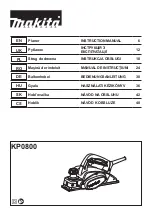
english 13
Joining, Fig. 8
Use the work stopper for this purpose, leave the planer
shaft protector on the table and set the protective rails to
the width of the work piece. Push the work piece against
the planer stopper and then lead it over the planer shaft
with both hands. As long as the board reaches high
enough on the receiving table, put the left hand on it and
shift it without interruption over the blade shaft.
Planer work – shavings emission, Fig. 9
While work, the work table must be locked. The extraction
tube should be connected to the extraction hood. When
connected to the extraction unit can then be extracted.
Extraction connection caliber 100mm
Planer thicknessing – machine adjustment, Fig. 10.1
Set the work table high and open it. Adjust the height to
the highest possible. Set a high pivot and heighten (bolt).
Attach the extraction connections and tighten the knurled
screw. When connected to the extraction unit can then be
extracted.
Planer thicknessing – table adjustment, Fig. 10.2
The height of the thicknessing table is adjustable by a
hand wheel. The integrated position gauge indicates aper-
ture height from 5 to 210 mm.
One rotation of the hand wheel corresponds to 2 mm Keep
the thicknessing table and the work table free of resin.
Shaving thicknes max. 3 mm. The graduation lines on the
graduated collar make a fine adjustment possible, where-
by 1 graduation line corresponds to 0, 05 mm.
• V-belt tension motor, Fig. 11, 12, 12.1 + 12.2
Warning!
re-tighten the flat belt and v-belt after the first 3 hours of op-
eration. then check the belt tension and regularly re-tighten,
if necessary, after 40 operating hours.
• Remove 4 hexagon sockets on both inner sides of the
encasing, Fig. 11.
• Remove both side walls.
• Losen clamping nut A on both sides (Fig. 13.1 +
13.2).
• Push the motor seesaw down.
• Tighten clamping nut A on both sides.
• Attach the side walls.
V-belt feeder cylinders, Fig. 11, 12 + 13.3
• Remove 4 hexagon sockets on both inner sides of the
encasing, Fig. 11 + 12.
• Take off the sides.
• Losen 4 hexagon nuts B, Fig. 13.3.
• Adjust belt tension.
• Tighten 4 hexagon nuts B.
• Loosen the “C” screw, tighten the v-belt, then re-tight-
en the “C” screw
• Attach the side walls.
Feeder cylinders adjustment, Fig. 14
To guarantee an efficient feeder the pressure springs must
be set to the adjacent dimensions.
changing of the feederfeeder cylinder, Fig. 15
The coating of feeder cylinders is from abrasion-resistant
rubber. After long-term great operational demand they can
suffer from abrasion, which will lead to a change of feed-
er-feeder cylinder.
1 Feeder cylinder
2 Support clip
3 Chain wheel
4 Spiral pivot
5 Pressure springs
6 Hexagon nut
• Perform the change as follows
• Remove 4 hexagon sockets on both inner sides, Fig.
11 + 12.
• Take off the sides.
• Take off feeder chain.
• Remove feeder cylinder (1) with a hexagon nut (6).
• Transfer the chain wheels to the new feeder cylinder.
• Install the new feeder cylinders.
• At the end, put the machine together again.
WOrK tABle sAFety
To prevent accidental closure of the work table, it is
equipped with a hinge shear. When closing the table no
special safety precautions need to be taken.
Work table, Fig. 6.1
The planer work chip removal is adjustable with the joint
lever 1 in 0 – 3 mm steps.
The work table can get displaced during the time of use
and an accurate to dimensions shavings removal is no
longer possible. In this case, the hexagon screws need
retightening, so that the work table could perform the ac-
curate shavings removal on its own.
m
residual risks
the machine is built according to the technical standard and
the recognized technical safety regulations. However, certain
residual risks can occur while operating.
• Risk of injury for fingers and hands by the rotating
planer shaft during improper manipulation of the work
piece.
• Injuries by a slipped work piece during improper han-
dling or manipulation, such as working without the
stopper.
• Health hazard from dust or wood shavings.
• Always wear personal protective equipment, such as
eye protection and dust mask. Use the extraction out-
let!
• Health hazard from noise. While operating, the noise
level will exceed the acceptable. Always wear personal
protective equipment, such as ear plugs.
• Hazard from electricity in case of usage of a defective
electrical power line.
• Process only selected woods without faults as: knots,
cross rifts, surface cracks. Bad wood will lead to risks
while operating.
• In addition, obvious residual risks exist despite all pre-
cautions taken.
• Residual risks can be minimized by observing the safe-
Содержание 190220290
Страница 83: ...rom n 81 75 75 75 6 1 1 0 3 90 120 6 2 7 75 75 1 2 8 9 100 10 1 10 2 5 210 2 3 1 0 05 11 12 12 1 12 2 3 40...
Страница 84: ...82 rom n 4 11 13 1 13 2 A 11 12 13 3 4 11 12 4 B 13 3 4 14 15 1 2 3 4 5 6 4 11 12 6 1 6 1 0 3 16 2...
Страница 87: ...1 rom n 85...
Страница 116: ...114...
Страница 117: ...115 80 international...
Страница 118: ...116 78 international...
Страница 119: ...117 international 79...
Страница 120: ...118 80 international...
Страница 121: ...119 international 81...
Страница 122: ...120 82 international...
Страница 123: ...121 international 83...
Страница 124: ...122 84 international...
Страница 125: ...123 international 85 71370045 71370046 06 06 2008...
Страница 126: ...124 0RWRU EURZQ EOXH EODFN UHG ZKLWH EOXH EODFN 8 EOXH EODFN EURZQ 9 9 8 8 0RWRU JUH 9 9 8...
Страница 127: ...125...
Страница 128: ...126...
















































